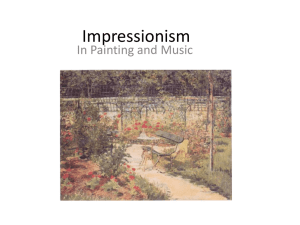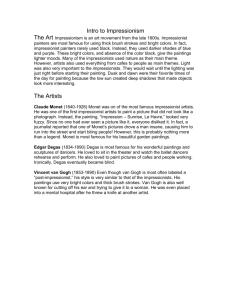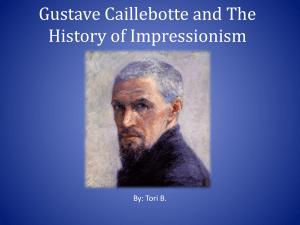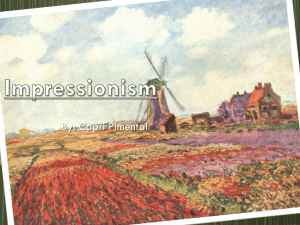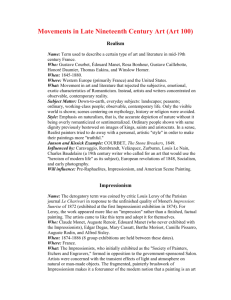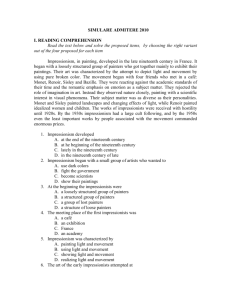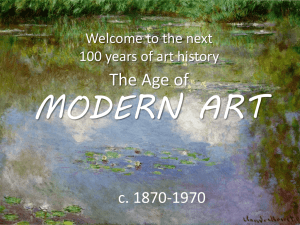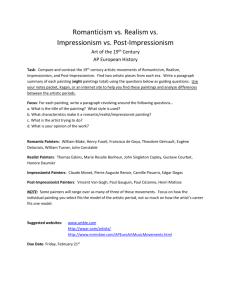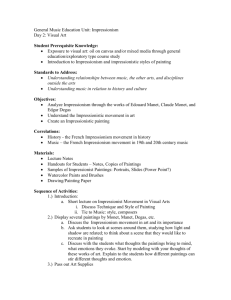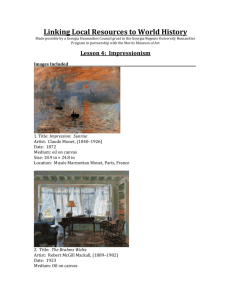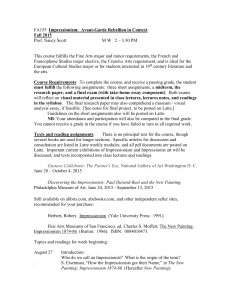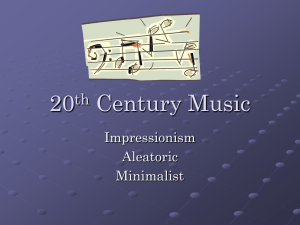Impressionism Reading - Henry County Public Schools
advertisement
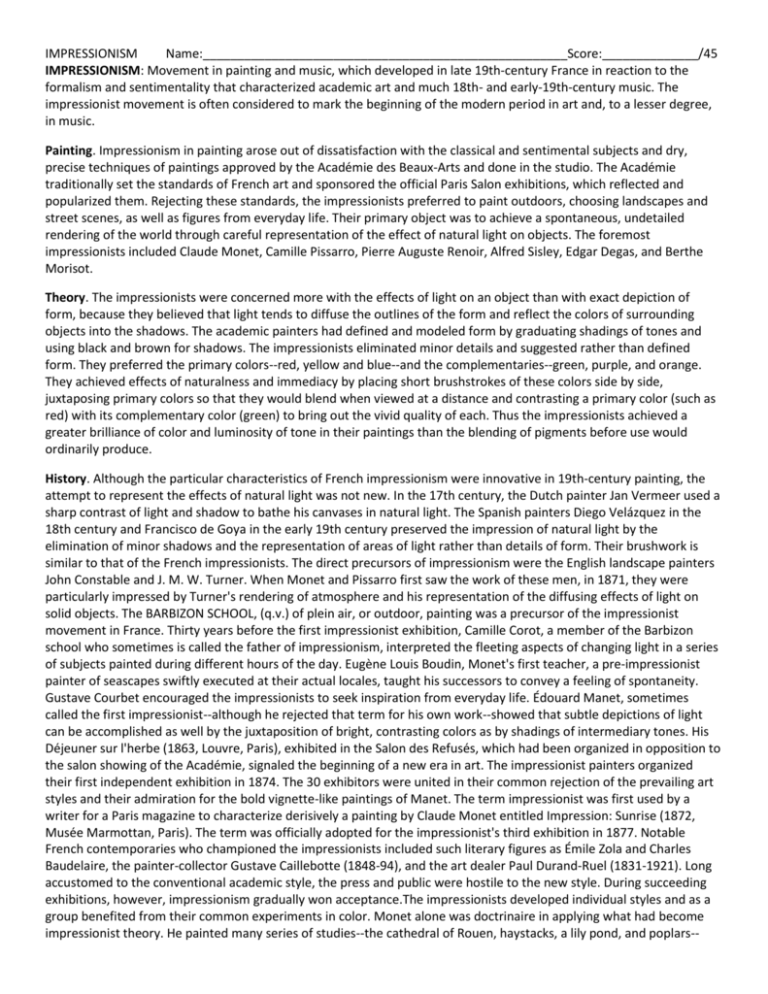
IMPRESSIONISM Name:_____________________________________________________Score:______________/45 IMPRESSIONISM: Movement in painting and music, which developed in late 19th-century France in reaction to the formalism and sentimentality that characterized academic art and much 18th- and early-19th-century music. The impressionist movement is often considered to mark the beginning of the modern period in art and, to a lesser degree, in music. Painting. Impressionism in painting arose out of dissatisfaction with the classical and sentimental subjects and dry, precise techniques of paintings approved by the Académie des Beaux-Arts and done in the studio. The Académie traditionally set the standards of French art and sponsored the official Paris Salon exhibitions, which reflected and popularized them. Rejecting these standards, the impressionists preferred to paint outdoors, choosing landscapes and street scenes, as well as figures from everyday life. Their primary object was to achieve a spontaneous, undetailed rendering of the world through careful representation of the effect of natural light on objects. The foremost impressionists included Claude Monet, Camille Pissarro, Pierre Auguste Renoir, Alfred Sisley, Edgar Degas, and Berthe Morisot. Theory. The impressionists were concerned more with the effects of light on an object than with exact depiction of form, because they believed that light tends to diffuse the outlines of the form and reflect the colors of surrounding objects into the shadows. The academic painters had defined and modeled form by graduating shadings of tones and using black and brown for shadows. The impressionists eliminated minor details and suggested rather than defined form. They preferred the primary colors--red, yellow and blue--and the complementaries--green, purple, and orange. They achieved effects of naturalness and immediacy by placing short brushstrokes of these colors side by side, juxtaposing primary colors so that they would blend when viewed at a distance and contrasting a primary color (such as red) with its complementary color (green) to bring out the vivid quality of each. Thus the impressionists achieved a greater brilliance of color and luminosity of tone in their paintings than the blending of pigments before use would ordinarily produce. History. Although the particular characteristics of French impressionism were innovative in 19th-century painting, the attempt to represent the effects of natural light was not new. In the 17th century, the Dutch painter Jan Vermeer used a sharp contrast of light and shadow to bathe his canvases in natural light. The Spanish painters Diego Velázquez in the 18th century and Francisco de Goya in the early 19th century preserved the impression of natural light by the elimination of minor shadows and the representation of areas of light rather than details of form. Their brushwork is similar to that of the French impressionists. The direct precursors of impressionism were the English landscape painters John Constable and J. M. W. Turner. When Monet and Pissarro first saw the work of these men, in 1871, they were particularly impressed by Turner's rendering of atmosphere and his representation of the diffusing effects of light on solid objects. The BARBIZON SCHOOL, (q.v.) of plein air, or outdoor, painting was a precursor of the impressionist movement in France. Thirty years before the first impressionist exhibition, Camille Corot, a member of the Barbizon school who sometimes is called the father of impressionism, interpreted the fleeting aspects of changing light in a series of subjects painted during different hours of the day. Eugène Louis Boudin, Monet's first teacher, a pre-impressionist painter of seascapes swiftly executed at their actual locales, taught his successors to convey a feeling of spontaneity. Gustave Courbet encouraged the impressionists to seek inspiration from everyday life. Édouard Manet, sometimes called the first impressionist--although he rejected that term for his own work--showed that subtle depictions of light can be accomplished as well by the juxtaposition of bright, contrasting colors as by shadings of intermediary tones. His Déjeuner sur l'herbe (1863, Louvre, Paris), exhibited in the Salon des Refusés, which had been organized in opposition to the salon showing of the Académie, signaled the beginning of a new era in art. The impressionist painters organized their first independent exhibition in 1874. The 30 exhibitors were united in their common rejection of the prevailing art styles and their admiration for the bold vignette-like paintings of Manet. The term impressionist was first used by a writer for a Paris magazine to characterize derisively a painting by Claude Monet entitled Impression: Sunrise (1872, Musée Marmottan, Paris). The term was officially adopted for the impressionist's third exhibition in 1877. Notable French contemporaries who championed the impressionists included such literary figures as Émile Zola and Charles Baudelaire, the painter-collector Gustave Caillebotte (1848-94), and the art dealer Paul Durand-Ruel (1831-1921). Long accustomed to the conventional academic style, the press and public were hostile to the new style. During succeeding exhibitions, however, impressionism gradually won acceptance.The impressionists developed individual styles and as a group benefited from their common experiments in color. Monet alone was doctrinaire in applying what had become impressionist theory. He painted many series of studies--the cathedral of Rouen, haystacks, a lily pond, and poplars-- IMPRESSIONISM Name:_____________________________________________________Score:______________/45 each study painted at different times of the day and in different seasons. Pissarro used a subdued palette and concentrated equally on the effects of light and on the structure of forms. Sisley, although greatly influenced by Monet, retained his own delicacy of style. Degas, who was not an orthodox impressionist, caught the fleeting moment, especially in ballet and horse-racing scenes. Renoir preferred to paint the female form rather than pure landscapes. Morisot's subtly painted landscapes gained strength from brushwork rather than color. French impressionism influenced artists throughout the world. The most outstanding was the American J. A. M. Whistler, whose so-called nocturnes (c. 1877) represent such effects as fireworks or lights shining through mists. Other artists include the Americans Mary Cassatt, Childe Hassam, Winslow Homer, and John Singer Sargent, the Englishman Walter Sickert, the Italian Giovanni Segantini (1858-99), and the Spaniard Joaquín Sorolla (1863-1923).Impressionism had far-reaching effects. Painters who began as impressionists developed other techniques, which started new movements in art. The French painters Georges Seurat and Paul Signac painted entire canvases with small dots of color in a scientific application of impressionist theory known as pointillism. The postimpressionists Paul Cézanne, Henri de Toulouse-Lautrec, Paul Gauguin, and Vincent van Gogh were greatly influenced by the impressionists' brilliant use of color. Cézanne's work anticipated cubism, while that of Gauguin and van Gogh was an early stage of expressionism. Music. The impressionist movement in music was led by the French composer Claude Debussy. Influenced by the paintings of the French impressionists and by the poetry of Paul Verlaine, Charles Baudelaire, and Stéphane Mallarmé, musical impressionism emphasized tonal color and mood rather than formal structures such as the sonata and the symphony. Debussy, an active critic as well as a composer, viewed impressionism as a reaction to both the formal emphasis of such composers as Wolfgang Amadeus Mozart and Ludwig van Beethoven and the sentimentalism of romantic composers such as Robert Schumann and Franz Schubert. In pursuit of this goal, Debussy developed a combination of new and ancient devices in his music. On the one hand he used the whole-tone scale and complex, hitherto unexploited intervals of the ninth and higher; on the other hand he returned to the parallel fourth and fifth intervals of the medieval church modes. These technical features were fully developed in Debussy's early orchestral work, Prelude to the Afternoon of a Faun (1894), based on a poem by Mallarmé. The extensive piano literature composed by Debussy required new performing techniques, including generous but sensitive use of the pedals. French impressionist music continued to develop in the work of Maurice Ravel. Other French composers of the impressionist school were Paul Dukas and Albert Roussel. Outside of France various aspects of Debussy's style were imitated by a number of composers, such as Frederick Delius and Ralph Vaughan Williams in England, Ottorino Respighi in Italy, and Manuel de Falla in Spain. By the beginning of World War I, the over-refinement and technical limitations of impressionism provoked adverse criticism from composers and critics alike. A new group of anti-romantic French composers, Les Six, influenced by Erik Satie, satirized and revolted against these excesses. Eventually, impressionism, which had been conceived by Debussy as a revolt against romanticism, came to be regarded as the final phase of romantic music. 1. What helped to create Impressionist painting? ___________________________________________________________________________________________ ___________________________________________________________________________________________ ___________________________________________________________________________________________ ___________________________________________________________________________________________ 2. What were characteristics of Impressionist Painting? ___________________________________________________________________________________________ ___________________________________________________________________________________________ ___________________________________________________________________________________________ ___________________________________________________________________________________________ 3. Who were the leading artists of the movement? ___________________________________________________________________________________________ ___________________________________________________________________________________________ ___________________________________________________________________________________________ ___________________________________________________________________________________________ IMPRESSIONISM Name:_____________________________________________________Score:______________/45 4. What was Impressionist art focused on? ___________________________________________________________________________________________ ___________________________________________________________________________________________ ___________________________________________________________________________________________ ___________________________________________________________________________________________ 5. What was the color pallet of Impressionism? ___________________________________________________________________________________________ ___________________________________________________________________________________________ ___________________________________________________________________________________________ ___________________________________________________________________________________________ 6. What did the artists achieve from not blending colors? ___________________________________________________________________________________________ ___________________________________________________________________________________________ ___________________________________________________________________________________________ ___________________________________________________________________________________________ 7. How did artists such as Vermeer and de Goya influence Impressionism? ___________________________________________________________________________________________ ___________________________________________________________________________________________ ___________________________________________________________________________________________ ___________________________________________________________________________________________ 8. How did various schools influence Impressionism? ___________________________________________________________________________________________ ___________________________________________________________________________________________ ___________________________________________________________________________________________ ___________________________________________________________________________________________ 9. Why did Manet reject the claim that he was the first Impressionist? ___________________________________________________________________________________________ ___________________________________________________________________________________________ ___________________________________________________________________________________________ ___________________________________________________________________________________________ 10. What was Monet’s place in the development of Impressionism? ___________________________________________________________________________________________ ___________________________________________________________________________________________ ___________________________________________________________________________________________ ___________________________________________________________________________________________ 11. What were characteristics of Impressionist music? ___________________________________________________________________________________________ ___________________________________________________________________________________________ ___________________________________________________________________________________________ ___________________________________________________________________________________________ 12. What was Debussy’s place in the movement? ___________________________________________________________________________________________ ___________________________________________________________________________________________ ___________________________________________________________________________________________ ___________________________________________________________________________________________
